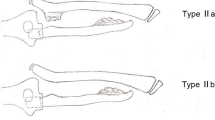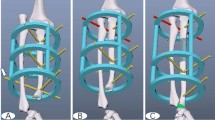Abstract
Background
Treatment for forearm deformities caused by hereditary multiple osteochondromas is still controversial. The purpose of the study was to describe the outcome of treatment with the combined use of ulnar lengthening and excision of osteochondromas.
Methods
Fourteen patients with hereditary multiple osteochondromas had forearm deformities which belongs to type I Masada deformity. The mean relative ulnar shortening was 19.9 mm (range, 16–23). All patients ranging from 4 to 15 years old had operative treatment. Clinical evaluation involving the assessment of pain, activities of daily living, and range of motion of the wrist and forearm was performed. The radiographic evaluation was relative ulnar shortening (RUS), radial articular angle (RAA), carpal slip (CS), and radial bowing. Besides, we also evaluated the amount of ulnar lengthening, external fixation time, and external fixation index.
Results
The mean EFT was 101 days (range, 84–133), and the mean external fixation index was 44.4 days/cm (range, 33.6–51.2). During the mean 43.1 months follow-up, four patients had mild pain and two patients had mild restriction of daily activities. The rotation of forearm and motion of wrist had increased except in Case 3. The RAA, CS, and radial bowing had been improved except in Case 6 and 7. In all patients, relative ulnar shortening had been corrected. According to the functional evaluation criteria recommended by Krimmer, there were ten excellent and four good.
Conclusions
The combined use of ulna lengthening and excision of osteochondromas is a proper and effective treatment method to the type I Masada deformity with the relative ulnar shortening more than 15 mm.



Similar content being viewed by others
References
Porter DE, Emerton ME, Villanueva-Lopez F et al (2000) Clinical and radiographic analysis of osteochondromas and growth disturbance in hereditary multiple exostoses. J Pediatr Orthop 20:246–250
Ogden JA (1976) Multiple hereditary osteochondroma: report of early case. Clin Orthop Relat Res 116:48–60
Fogel GR, McElfresh EC, Peterson HA et al (1984) Management of deformities of the forearm in multiple hereditary osteochondromas. J Bone Jt Surg Am 66:670–680
Schmale GA, Conrad EU 3rd, Raskind WH (1994) The natural history of hereditary multiple exostoses. J Bone Jt Surg Am 76:986–992
Wood VE, Sauser D, Mudge D (1985) The treatment of hereditary multiple exostosis of the upper extremity. J Hand Surg Am 10:505–513
Bock GW, Reed MH (1991) Forearm deformities in multiple cartilaginous exostoses. Skeletal Radiol 20:483–486
Masada K, Tsuyuguchi Y, Kawai H et al (1989) Operations for forearm deformity caused by multiple osteochondromas. J Bone Jt Surg Br 71:24–29
Burgess RC, Cates H (1993) Deformities of the forearm in patients who have multiple cartilaginous exostosis. J Bone Jt Surg Am 75:13–18
Matsubara H, Tsuchiya H, Sakurakichi K et al (2006) Correction and lengthening for deformities of the forearm in multiple cartilaginous exostoses. J Orthop Sci 11:459–466
Pritchett JW (1986) Lengthening the ulna in patients with hereditary multiple exostoses. J Bone Jt Surg Br 68:561–565
Stanton RP, Hansen MO (1996) Function of the upper extremities in hereditary multiple exostoses. J Bone Jt Surg Am 78:568–573
Noonan KJ, Levenda A, Snead J et al (2002) Evaluation of the forearm in untreated adult subjects with multiple hereditary osteochondromatosis. J Bone Jt surg Am 84:397–403
Arms DM, Stecker WB, Manske PR et al (1997) Management of forearm deformity in multiple hereditary osteochondromatosis. J Pediatr Orthop 17:450–454
Shin EK, Jones NF, Lawrence JF (2006) Treatment of multiple hereditary ostechondromas of the forearm in children: a study of surgical procedures. J Bone Jt Surg Br 88:255–260
Akita S, Murase T, Yonenobu K et al (2007) Long-term results of surgery for forearm deformities in patients with multiple cartilaginous exostoses. J Bone Jt Surg Am 89:1993–1999
Ishikawa J, Kato H, Fujioka F et al (2007) Tumor location affects the results of simple excision for multiple osteochondromas in the Forearm. J Bone Jt Surg Am 89:1238–1247
Zhang X, Duan L, Li Z et al (2007) Callus distraction for the treatment of acquired radial club-hand deformity after osteomyelitis. J Bone Jt Surg Br 89:1515–1518
Krimmer H, Wiemer P, Kalb K (2000) Comparative outcome assessment of the wrist joint mediocarpal partial arthrodesis and total arthrodesis. Handchir Mikrochir Plast Chir 32:369–374
Nishiwaki M, Nakamura T, Nakao Y et al (2005) Ulnar shortening effect on distal radioulnar joint stability: a biomechanical study. J Hand Surg Am 30:719–726
Nishiwaki M, Nakamura T, Naqura T et al (2008) Ulnar-shortening effect on distal radioulnar joint pressure: a biomechanical study. J Hand Surg Am 33:198–205
Watts AC, Ballantyne JA, Fraser M et al (2007) The association between ulnar length and forearm movement in patients with multiple osteochondromas. J Hand Surg Am 32:667–673
Nyqaard M, Nielsen NS, Bojsen-Moller F (2009) A biomechanical evaluation of the relative load change in the joints of the wrist with ulnar shortening: a ‘handbag’ model. J Hand Surg Eur 34:724–729
Jung JM, Baek GH, Kim JH et al (2001) Changes in ulnar variance in relation to forearm rotation and grip. J Bone Jt Surg Br 83:1029–1033
Mader K, Gausepohl T, Pennig D (2003) Shortening and deformity of radius and ulna in children: correction of axis and length by callus distraction. J Pediatr Orthop 12:183–191
Ip D, Li YH, Chow W et al (2003) Reconstruction of forearm deformities in multiple cartilaginous exotoses. J Pedistric Orthop B 12:17–21
Abe M, Shirai H, Okamoto M et al (1996) lengthening of the forearm by callus distraction. J Hand Surg Br 21:151–163
Dal Monte A, Andrisano A, Capanna R (1980) Lengthening of radius or ulna in asymmetrical hypoplasia of the forearm (report on 7 cases). Ital J Orthop Traumatol 6:329–342
Villa A, Paley D, Catagni MA et al (1990) Lengthening of forearm by Ilizarov technique. Clin Orthop Relat Res 250:125–137
Peteson BM, McCarroll HR Jr, James MA (2007) Distraction lengthening of the ulna in children with radial longitudinal deficiency. J Hand Surg Am 32:1402–1407
Conflict of interest
All authors declare no conflict of interest with this manuscript.
Author information
Authors and Affiliations
Corresponding author
Rights and permissions
About this article
Cite this article
Tang, Zw., Cao, Yl., Liu, T. et al. Management of forearm deformities with ulnar shortening more than 15 mm caused by hereditary multiple osteochondromas. Eur J Orthop Surg Traumatol 23, 611–618 (2013). https://doi.org/10.1007/s00590-012-1033-9
Received:
Accepted:
Published:
Issue Date:
DOI: https://doi.org/10.1007/s00590-012-1033-9




